#Sohag
Text
Vial Automatic Sticker Labelling Machine in Egypt

Laxmi Pharma Equipment is Manufacturer, Supplier and Exporter of Vial Automatic Sticker Labelling Machine in Egypt.
Our Manufacturing Unit is in Ahmedabad, Gujarat, India.
Vial Automatic Sticker Labelling Machine Manufacturer specializes in designing, producing, and supplying machines that automatically apply adhesive labels to vials.
These machines are essential for industries such as pharmaceuticals, cosmetics, food and beverage, and healthcare, where precise and efficient labelling is crucial.
Our machine applies labels to vials with pinpoint accuracy, ensuring each label is perfectly aligned and securely affixed.
Boost your production efficiency with rapid labelling capabilities that keep your packaging line moving smoothly and quickly.
Features:
No change parts are required for change over of Vials size.
Synchronized speed of Label Dispensing, Conveyor and Pressing Device.
Easy to change label application height.
Self protected against any voltage fluctuations.
Suitable for On-Line Ink Jet and Contact Coding System.
Suitable for Partial, Full Wrap Around and Overlap Labeling.
High Production Speed up to 250 Vials/min.
PLC based system with touch screen HMI.
Conveyor & servo speed synchronized and controlled from HMI.
In built Speed Indicator & Counter.
There is no requirement of Oil or Grease for maintenance.
Online rejection system (if required).
Applications:
Pharmaceuticals
Laboratory Equipment
Food and Beverage
Cosmetics
Healthcare
Laxmi Pharma Equipment is an Exporter of Vial Automatic Sticker Labelling Machine in Egypt Including Cario, Alexandria, Giza, Shubra el-Khema, Port Said, Suez, EL mahalla el Kubra, El Mansoura, Tanta, Asyut, Fayoum, Zagazig, Ismailia, Khusus, Aswan, Damanhur, El- Minya, Damietta, Luxor, Qena, Beni Suef, Sohag, Shibin el-Kom, Hurghada, Banha, Mallawi.
For more information and inquiries, feel free to contact us.
View Product: Click Here
Read the full article
#Alexandria#Aswan#Asyut#Banha#BeniSuef#Cario#Damanhur#Damietta#ELmahallaelKubra#ElMansoura#El-Minya#Exporter#ExporterofVialAutomaticStickerLabellingMachineinEgypt#Fayoum#Giza#Gujarat#Hurghada#India#Ismailia#Khusus#LaxmiPharmaEquipment#Luxor#Mallawi#Manufacturer#ManufacturingUnitisinAhmedabad#PortSaid#Qena#Shibinel-Kom#Shubrael-Khema#Sohag
0 notes
Text
https://www.outsourcingpark.net/
Outsourcing Park is the best digital marketing learning institute of Bangladesh.
1 note
·
View note
Text
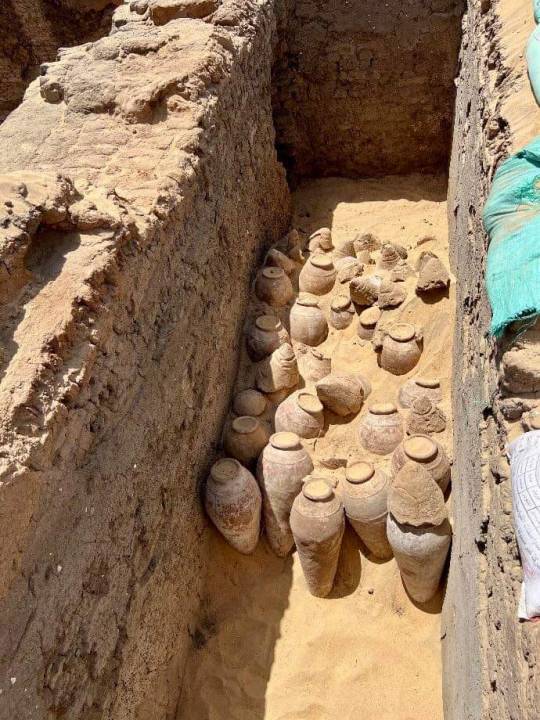
Archaeologists Uncover 5,000-Year-Old Wine in Egypt
A new discovery has been made by an archaeological team from Egypt, Germany, and Austria working in Upper Egypt. They found some 5,000-year-old wine inside sealed jars that had never been opened.
This discovery was made in Queen Merneith’s tomb in Abydos, Sohag. In addition to the ancient wine, the team also found furniture that was used for funerals.
Mostafa Waziri, who is the Secretary General of the Supreme Council of Antiquities, shared on Sunday that these old jars are big and in good condition.
Dietrich Raue, who is the Director of the German Archaeological Institute, added that the team also found out more about the life of the ancient queen and the time she ruled.
When they looked at the writings on one of the tablets found in the tomb, they discovered that Queen Merneith had a significant role. She was in charge of important government offices, explained Dietrich Raue.
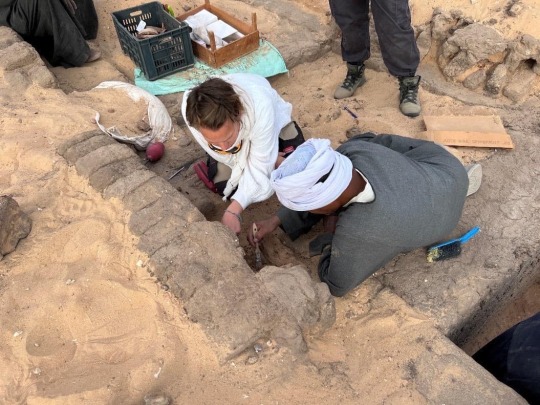
Raue also mentioned that the team is still working diligently to find out more about this enigmatic queen’s life.
Christiana Kohler, who leads the mission, revealed that their research into the tomb has revealed that it was constructed using materials like raw bricks, clay, and wooden planks.
Kohler pointed out that Queen Merneith’s royal tomb in Abydos is possibly the only one from the First Dynasty that has been found up to this point.
“This observation, together with other evidence, radically challenges the oft-proposed but unproven idea of ritual human sacrifice in the 1st Dynasty,” Kohler stated.
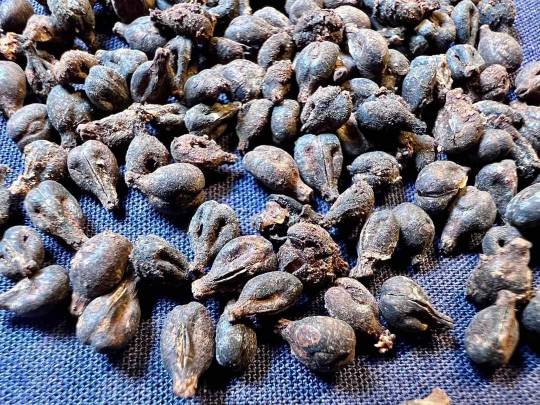
Additionally, she mentioned that there are 41 tombs near the queen’s tomb, which belong to her advisors and servants.
Queen Merneith was the first female pharaoh
There’s evidence to suggest that Queen Merneith might have been a ruler of Egypt on her own. This idea is based on official records.
If this turns out to be true, and the earlier royal wife, Neithhotep, didn’t rule independently, then Merneith could be considered the first female pharaoh and the earliest queen who ruled on her own in recorded history. She governed around 2950 BC for a period that we’re not sure about, according to Wikipedia.
Merneith’s name, which means “Beloved by Neith,” has symbols related to the ancient Egyptian deity Neith on her stele. She might have been the daughter of Djer and likely the senior wife of Djet.
Being Djer’s daughter would make her the great-granddaughter of Narmer, the first pharaoh to unite Egypt. She was also the mother of Den, who succeeded her as ruler.
By Abdul Moeed.
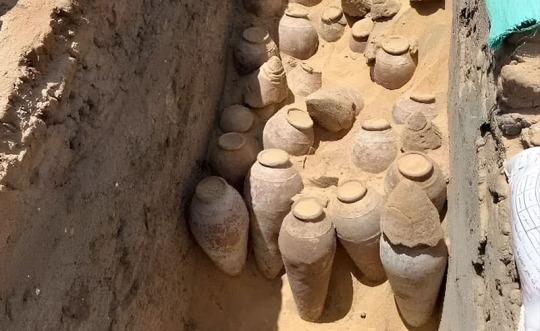
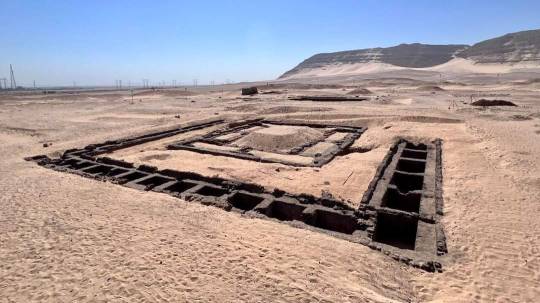
#Archaeologists Uncover 5000-Year-Old Wine in Egypt#Queen Merneith’s tomb in Abydos Sohag#first dynasty#ancient tomb#ancient grave#ancient artifacts#archeology#archeolgst#history#history news#ancient history#ancient culture#ancient civilizations#ancient egypt#egyptian history
111 notes
·
View notes
Text

By Teodor Kuduschiev
10 notes
·
View notes
Text
2 notes
·
View notes
Text
This is pretty cool. An excavation in Egypt of a 1st Dynasty tomb (about 5000 years old) made two pretty huge discoveries.
First, they found still-sealed and well-preserved jars of wine. This is going to be invaluable for gathering information about wine making in the era along with agricultural capabilities (because the fruit to make the wine had to come from somewhere and they can learn a lot about it).
Second, they discovered evidence that shows the 1st Dynasty did NOT practice human sacrifice. One hypothesis over the years was that, when someone important died in Egypt, they would sacrifice that person's servants to be buried with them to serve them in the afterlife. Well, this tomb had an important person and many of their servants buried in it, but the construction of the tomb was over a long period of time - many years. Meaning it's far more likely they were just buried there as they died naturally rather than sacrificed.
304 notes
·
View notes
Text

A Coptic man and woman in al-Kosheh village ,, Sohag _ Egypt ..
📷: Rena Effendi
60 notes
·
View notes
Text
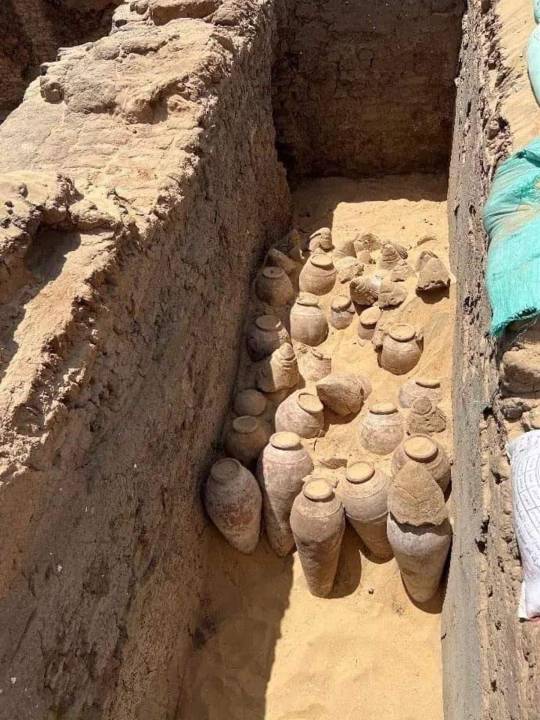
5000-Year-Old Pharaonic wine jars found intact at Abydos
The Egyptian-German-Austrian archaeological mission excavating the tomb of Queen Merit-Neith of the 1st Dynasty in Umm El Qa’ab at Abydos in Sohag, succeeded in uncovering hundreds of sealed jars, containing remnants of wine, in addition to uncovering a group of funerary equipment.
Mostafa Waziri, Secretary General of the Supreme Council of Antiquities, said the archaeological team found several grave goods, including hundreds of large wine jars, some of which had intact stoppers and contained the well-preserved remains of 5000-year-old wine.
Inscriptions also indicate that Merit-Neith had been in charge of central government offices, like the treasury, which lends credence to the theory that she played a historically significant role, Waziri noted.
Read more
114 notes
·
View notes
Text
Still sealed. Incredible preservation.
57 notes
·
View notes
Text
Memorising governorates of Egypt with a mind palace

Image source
There are 27 governorates in Egypt. Here's how I memorise them:
Alexandria, Aswan = Alex in a swan costume in entrance
Asyut,Beheira = someone dippin their but in a lake by the phone shop
Beni Suef, Cairo = ben ten with a sword (sef in arabic) in cairo by the garage
Dakahlia, Damietta = white lady eating feta cheese by the pharmacy (dakahlia's capital is mansoura, which is famously full of "white" egyptians, damietta sounds like an egyptian brand of cheese)
Faiyum, Gharbia = a tree shade (Fai) to the west by the building
Giza, Ismailia = Ismael on top of pyramid by the tech store
Kafr El-Sheikh, Luxor = a sheikh in statue form (luxor famous for temples) by the bakers
Matrouh, Minya = king mina being kicked out of the lab
Monufia, New Valley = dad (from monufia) climbing a valley by the veggies seller
North Sinai, Port Said = a poor guy holding a sign high by the kiosk
Qalyubia, Qena = a tv turned upside down by the orphanage
Red Sea, Sharqia = a guy choking (sharaq) on red water by the corner
Sohag, South Sinai = horny dude holding a sign low by the school
Suez = a canal in the ruins of a building
8 notes
·
View notes
Text

wooden sarcophagus from akhmim, sohag, egypt, c. 50 b.c.- 50 a.d.
british museum. EA29587
29 notes
·
View notes
Text
Visual Inspection Conveyor in Egypt

Company Overview:
Laxmi Pharma Equipment, headquartered in India, is a prominent Manufacturer, Supplier, and Exporter of Visual Inspection Conveyor in Egypt.
Laxmi Pharma Equipment specializes in Visual Inspection Tables/Conveyor Units, essential equipment in the pharmaceutical industry for visually inspecting tablets, capsules, vials, ampoules, and other dosage forms.
These units facilitate the assessment of goods' quality, integrity, and compliance with industry standards and regulations in a controlled environment.
Features:
Well-illuminated work surface with uniform and glare-free lighting for optimal visibility.
Conveyor system for smooth product transport across the inspection table, with adjustable speed controls.
Lighting controls to adjust intensity and direction for optimal visibility during inspection.
Automated rejection or separate accumulation of products not meeting quality standards.
Intuitive interface for easy control of conveyor speed, lighting, and other settings.
Data recording capabilities for documenting inspection results and generating reports for quality control purposes.
Exporter of Coverage in Egypt:
Laxmi Pharma Equipment is Exporter of Visual Inspection Conveyor in Egypt like Cario, Alexandria, Giza, Shubra el-Khema, Port Said, Suez, EL mahalla el Kubra, El Mansoura, Tanta, Asyut, Fayoum, Zagazig, Ismailia, Khusus, Aswan, Damanhur, El- Minya, Damietta, Luxor, Qena, Beni Suef, Sohag, Shibin el-Kom, Hurghada, Banha, Malawi.
For further inquiries or to explore our product catalog, please don't hesitate to reach out to us using the provided contact information.
Read the full article
#Alexandria#Aswan#Asyut#Banha#BeniSuef#Cario#Damanhur#Damietta#Egypt#ELmahallaelKubra#ElMansoura#El-Minya#Exporter#ExporterofVisualInspectionConveyor#ExporterofVisualInspectionConveyorinEgypt#Fayoum#Giza#Hurghada#Ismailia#Khusus#Luxor#Malawi#Manufacturer#PortSaid#Qena#Shibinel-Kom#Shubrael-Khema#Sohag#Suez#Supplier
0 notes
Text
A Note on Šahrwarāz in Egypt
Šahrwarāz was the general involved in the conquest of the Roman Empire in the early seventh century CE and became a main actor in the “Last Great War of Antiquity.” Šāhrwarāz, along with the other Sasanian general, Šāhēn were instructed by king of kings, Khosrow II to conquer the eastern territory of the Roman Empire. Indeed, these generals were able to do what was planned by the court and the king and by 619 CE, Šahrwarāz had reached Egypt and the Persians would be in control there till 628 CE. While we have Pahlavi, Greek Coptic papyri from the period of Sasanian presence in Egypt, and we know that in 630 CE Šahrwarāz ruled as the king of kings, we do not have any coins or images of this all-important person. In many ways the Sasanian Empire was brought down by the coup and the probable complicity of Šahrwarāz and not the invasion of the Emperor Heraclius. Understanding the developments in Sasanian Iranshahr between 626 and 630 CE is a key factor in the history of the period. I would point to W. Kaegi (2003) and James Howard-Johnston (2006) whose attention to Heraclius and the great war of the world in the seventh century have given us the basic outline of what took place. The historiography of Šahrwarāz now been masterfully presented by Hameen-Anttila (2022), where we can trace the historiography of Šahrwarāz as presented in the Roman and Iranian based sources. Still, no pictorial images of Šahrwarāz is available and a biography of his is needed to be written.
Šahrwarāz’s name appears in various forms, such as in Persian as Šahrbarāz and his title Gurāz “boar” in the Šāhnāmeh. This is however one of the titles of the man whose real name is Farroxān, who is the Šāhnāmeh is mentioned as Ferāyīn, and in the Armenian and Georgian sources as Xrean and with similar forms. Tabari states that Farroxān had the rank of Šāhrwarāz (Tabari 1999, p. 319), meaning “Boar of the Empire,” But it is interesting that he may have had other titles, for example Razmyōzān (Tabari 1999, 318), meaning the “War Panther,” variously appearing as Rozmyōzān, Ruzmiozan, Rozmi-Ozan, Razmiołan, Ruzi Bahan (Noldeke 1879, p. 292, ft. 2 : Justi 1895, p. 277 : Hübschman 1893, p. 622-624 : Dowsett, 1961, p. 77, ft. 2).
It is also interesting that the highest ranking Sasanian personage in the Pahlavi papyri from Egypt (619-628 CE), who carries the title of Kārframān ī dar, a “Chief of the Court,” has the title or named Σαρϱαλανεοζᾶν / Saralaneozan, which renders Šahr-Ālānyōzān (Sanger 2011, p. 654), and this person has certainly been identified as Šahrwarāz by J. Banaji (2019). But what is to be meant by Šahr-Ālānyōzān? Of course the simple answer is the “Alanian Panther of the Empire.” This affiliation remind me of the Georgian The Knight in the Panther's Skin of Shota Rustaveli and his heroic deeds who took place in lands of Arabia and India. We should be reminded that there are other generals with similar feline titles in the Sasanians period, for example Sar-palang “Leopard Head,” which again reminds of the Georgian Vakhtang Gorgasali.
There are new finds which suggest the strong Persian presence in Egypt, most notably a Sasanian plate (Azarnouche, Fragaki, Grenet 2020). The Getty Villa had an amazing exhibition and a catalogue on Ancient Iran, edited by J. Spier, T. Potts, and S.E. Cole. One of the pieces that caught my eye there was a bone plaque found in Sohag, in Upper Egypt (2022, 315). The piece is certainly Sasanian in style and the catalogue suggests that it is an “enthroned king.” Leaving aside that the plaque may be post-Sasanian, I noticed that while the figure is seated like a ruler, he is not wearing a crown! So, the figure is seating on a throne, but with no crown; it is from Egypt and most likely from the Sasanian period. Who could this person be? To my mind a strong possibility would be Šahrwarāz.

From the Persian: Ancient Iran and the Classical World, Getty Villa Catalogue, eds. J. Spier, T. Potts, S.E. Cole, 2022.
This is just a blog!
Shall write the article soon.
11 notes
·
View notes
Text
An Overview of Waterproof Breathable Fabrics
An Overview of Waterproof Breathable Fabrics
#waterproof #waterprooffabric #waterbreathable
An Overview of Waterproof Breathable Fabrics
Ariful Hasan, Al-amin Sohag, Lutfur Rahman, Uzzal Hossain, NM Walid
Department of Textile Engineering
Daffodil International University
Introduction:
Waterproof breathable fabrics are designed for use in garments that protection from the weather, that is from wind, rain and loss of body heat. Waterproof fabric completely prevents the penetration and…

View On WordPress
2 notes
·
View notes
Text
Sohag Museum es uno de los mayores museos regionales de Egipto y contiene muchas colecciones arqueológicas increíbles
@cairo-top-tours
#cairotoptours
5 notes
·
View notes



